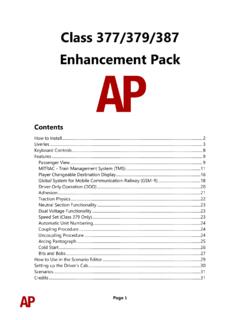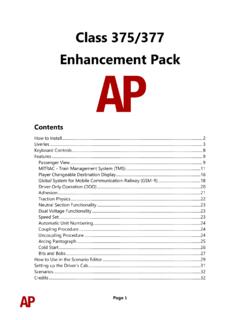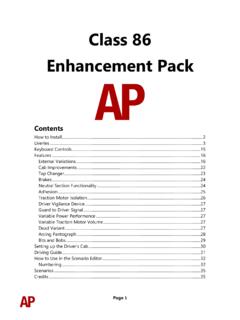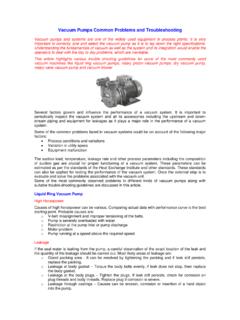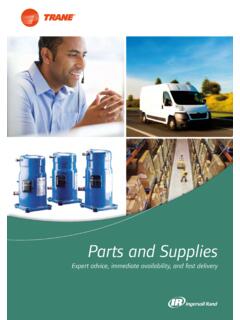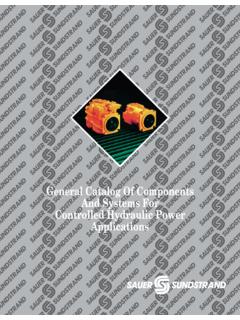Transcription of Class 168/170/171 Enhancement Pack - Armstrong …
1 Page 1 Class 168/170/171 Enhancement pack Contents How to install .. 2 Liveries .. 3 Keyboard Controls .. 15 Features .. 16 Voith T211rzze hydraulic Transmission .. 17 Adhesion .. 18 Cooling Fan Simulation .. 19 Automatic Unit Numbering .. 20 Dynamic Exhaust Effects .. 20 Player Changeable Destination Display .. 21 Bits and Bobs .. 24 Setting Up the Driver s Cab .. 25 Scenarios .. 25 Credits .. 25 Page 2 How to Install 1) Locate where you have downloaded this pack and unzip it. Information on how to do this can be found here. 2) Go to the location where you have extracted the files from the .zip file. 3) Now find the .exe file called Class 168-170-171 Enhancement pack . Double-click this file. 4) Follow the steps and by the end of the process, the main part of this pack will have installed.
2 5) If you intend to use any of the included scenarios, make sure you have the freely available extra stock pack and requirements installed, as listed on the product page. 6) To ensure the cab environment sounds as intended in this pack , please make sure that EFX is ticked within your in-game Audio settings. Page 3 Liveries Class 168 Chiltern Railways - CR AP Chiltern Railways (Mainline) - CR (M) AP Page 4 Class 170 Anglia Railways - AR AP Anglia Railways (Revised) - AR Rev AP Page 5 ONE - ONE AP ONE Dark - ONE Dark AP Page 6 Ex-Anglia Railways (Revised) (NXEA/AGA/GA/GA2) - Ex-AR Rev (NXEA/AGA/GA/GA2) AP Ex-ONE (NXEA/AGA/GA/GA2) - Ex-ONE (NXEA/AGA/GA/GA2) AP Page 7 Ex-ONE Dark (NXEA/AGA/GA) - Ex-ONE Dark (NXEA/AGA/GA) AP Greater Anglia - GA AP Page 8 Midland Mainline - MML AP Ex-Midland Mainline (Central Trains/CrossCountry) - Ex-MML (CT/XC)
3 AP Page 9 Central Trains - CT AP CrossCountry - XC AP Page 10 London Midland - LM AP South West Trains - SWT AP Page 11 Hull Trains - HT AP First Transpennine Express - FTPE AP Page 12 ScotRail - SR AP First ScotRail - FSR AP Page 13 SPT Rail - SPT Rail AP ScotRail Saltire - SR Salt AP Page 14 Class 171 Southern - SN AP Page 15 Keyboard Controls Non-standard keyboard controls are listed below:L - Cab light ON/OFF E - Deadman s pedal (DVD reset) F7 - Destination blind UP F8 - Destination blind DOWN Y - Driver reminder appliance (DRA) ON/OFF C - Driver to guard buzzer Ctrl+D - Driver vigilance device (DVD) ON/OFF Z - Engine start button Ctrl+Z - Engine stop button + - Hill start button Shift+W - Master key IN/OUT K - Tail lights switch ON/OFF V - Wiper switch CLOCKWISE Shift+V - Wiper switch ANTI-CLOCKWISE Page 16 Features 23 liveries Higher resolution cab visuals Detailed internal & external audio Accurate acceleration & braking physics Voith T211rzze hydraulic transmission Adhesion Cooling fan simulation Automatic unit numbering Dynamic exhaust effects Player changeable destination display Driver vigilance device (DVD) Bits and Bobs Page 17 Voith T211rzze hydraulic Transmission Great care has been taken in recreating the characteristics of the 2-stage hydraulic transmission used in this unit.
4 1st Stage - Torque Converter When accelerating from a standing start, oil fills the torque converter and the engine revs up, which allows acceleration to take place. Unlike the Class 15x family of units, the engine does not rev up until the oil has filled the converter, hence the lack of an initial surge of rpm before settling and a smooth increase in rpm instead. As a result, there is a 3 second delay between applying power and the engine responding. During this 1st stage, engine rpm is directly controlled via the notch selected on the power handle. 2nd Stage - Fluid Coupling At 70mph, the oil transfers from the torque converter to the fluid coupling which results in a reduction of engine rpm. During this stage, engine rpm is directly proportional to the speed of the train which means rpm will be the same regardless of which notch is selected on the power handle.
5 All that varies is the load being placed on the engine. As speed increases then, you will gradually hear engine rpm rise in sync. The unit will stay in this second stage until speed drops below 66mph. At this point, the transmission reverts to the first stage. Page 18 Adhesion Adhesion between a train s wheels and the rails plays a big part in allowing a train to accelerate or brake. Too little of it and the train will slip or slide. There are a myriad of factors that control the level of adhesion and we have attempted to simulate the most important of these to give a varied and realistic driving experience: Season Adhesion is generally good in dry conditions during summer and spring. Slightly decreased adhesion during winter to take account of the increased amount of moisture and possible ice on the rails due to cooler temperatures.
6 Much decreased adhesion during autumn due to leaf mulch. Weather Adhesion decreases in wet weather, especially so when rain first starts falling before it has had a chance to clean the railhead. If rain is light, it will take longer for the railhead to be cleaned whereas heavy rain will clean it quicker, resulting in adhesion recovering sooner. When using the drizzle weather pattern in our Sky & Weather Enhancement pack , adhesion is particularly poor as the rain hasn t enough force to clean the railhead but still makes it sufficiently wet to worsen adhesion. Time of Day Adhesion will decrease somewhat after dusk as the air cools and dew is more likely to form on the railhead. This persists throughout the night until around an hour after sunrise when higher temperatures or the sun dry it out.
7 In our simulation, this factor is reduced during summer to account for warmer temperatures, which on average result in less dew. Tunnels When adhesion is poor due to external factors such as weather or season, adhesion will generally improve upon entering a tunnel, which is not as susceptible to these factors. When adhesion is good during dry weather and outside of autumn, adhesion may decrease a little upon entering a tunnel due to their damp nature. Page 19 Wheelslip Wheelslip protection aids the driver when powering or braking during times of poor adhesion. When wheelslip is encountered during acceleration, a two stage process takes place: 1) Power is automatically reduced and the WSP Activity light flashes in the cab. 2) Once wheelslip stops, power is reapplied to the notch selected on the combined power handle and the WSP Activity light extinguishes.
8 If wheelslip reoccurs, the process starts again. As a driver, you must assess which power notch is most suitable for the conditions and balance the occurrence of wheelslip with the maximum possible rate of acceleration. Wheelslide When wheelslide is encountered during braking, a two stage process takes place: 1) Brake pressure is automatically reduced and the WSP Activity light flashes in the cab. 2) Once the wheelslide stops, brake pressure is returned to the notch selected on the combined power handle and the WSP Activity light extinguishes. If wheelslide reoccurs, the process starts again. As a driver, you must resist the temptation to reduce the brake yourself as the wheelslip protection will offer the best braking performance. Cooling Fan Simulation The distinctive cooling fan on these units has been simulated and is audible on the outside on the train.
9 How quickly the engine s temperature rises and how efficient the fan is at cooling it, primarily depends on the season but also on how hard the engine is being driven. For example, in the summer and with a lot of high speed running, you can expect it to be active a lot of the time. In contrast, during cooler months and with low speed running, it won t be active as much, especially in winter. On top of this, to reflect the variable nature of each engine and its efficiency at cooling, each engine is given a random efficiency rating at the start of a scenario, just to provide even more variation. Page 20 Automatic Unit Numbering When placing a unit in the scenario editor or using one in Quick Drive, all vehicles will automatically be given correct unit and coach numbers instead of you having to select each vehicle and changing their number manually so they match.
10 The unit number is usually controlled via the DMSL coach (this can vary depending on the particular formation of your chosen livery) if you wish to change it. Please note that the destination display on both driving coaches is also controlled via this coach. Dynamic Exhaust Effects Dynamic exhaust effects mean that the exhaust reacts to what the engine is doing. For example, when in notch 7, the engine will produce more exhaust than it would when idling. Also, when revving up, exhaust thickens before thinning out when rpm settles. Equally, when revving down, exhaust thins. On top of that, when starting up, exhaust rises in sync with the sound of the engine revving up. Finally, in reality, the smokiness of each vehicle varies depending on how well maintained it is, so to represent this in the simulator, a random clag factor is allocated to each vehicle which ranges from 1 to 10; 1 being the cleanest and 10 being the dirtiest.


